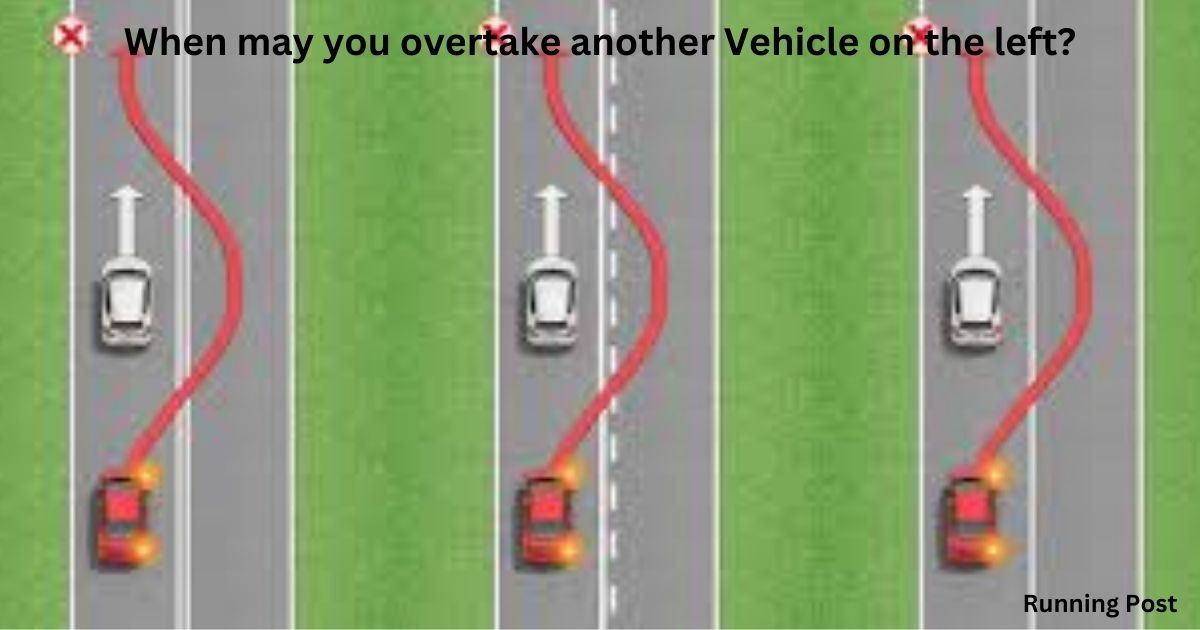A: When a slower vehicle is travelling in the right-hand lane of a dual carriageway
B: When you’re in a one-way street
C: When approaching a motorway slip road where you’ll be turning off
D: When the vehicle in front is signalling to turn left
Understanding Overtaking Rules on the Road
Overtaking is a common maneuver on the road, but it’s also one of the most dangerous if not done correctly. Understanding the rules surrounding overtaking is crucial for every driver, as it ensures not only your safety but also the safety of other road users. Overtaking occurs when one vehicle passes another traveling in the same direction. It may seem straightforward, but several legal and safety considerations come into play.
Firstly, overtaking should only be attempted when it’s safe and legal to do so. Many accidents occur because drivers misjudge the situation or ignore road signs and markings that prohibit overtaking. Understanding when and where you can overtake is the foundation of safe driving.
Additionally, overtaking isn’t just about getting ahead; it’s about doing so with minimal risk. Drivers should always consider factors like visibility, road conditions, and the behavior of other road users. For instance, overtaking on a blind curve or in heavy traffic can lead to severe consequences.
Finally, overtaking rules can vary depending on the type of road you’re on, the speed limit, and the presence of pedestrians or cyclists. It’s important to be aware of local traffic laws and road signs that indicate when overtaking is prohibited. By following these rules, drivers can reduce the risk of accidents and ensure a smoother flow of traffic.
When May a Driver Overtake?

Overtaking is a critical aspect of driving, allowing vehicles to pass slower traffic and maintain a steady flow on the roads. However, it’s not always legal or safe to overtake, and understanding when a driver may do so is essential.
- Legal Conditions: Drivers are generally allowed to overtake when the road ahead is clear, visibility is good, and there are no road signs or markings prohibiting the maneuver. It’s important to signal your intention to overtake and ensure there is enough space to safely complete the action without causing other drivers to brake suddenly or swerve.
- Safe Situations: Overtaking is typically safe on straight roads where visibility is high, and there is no oncoming traffic. In these situations, drivers should still be cautious and ensure they have checked their mirrors and blind spots. Overtaking in areas with low traffic density also reduces the risk of accidents.
- Speed Limits: Overtaking is usually permitted in areas where the speed limit allows for such maneuvers. For example, on highways and expressways, overtaking is a common practice. However, in areas with lower speed limits, overtaking may be restricted to specific zones.
Understanding these conditions helps drivers make informed decisions about when to overtake. It’s not just about legality; it’s about ensuring safety for everyone on the road.
Where Should You Avoid Overtaking?
Knowing where to avoid overtaking is just as important as knowing when you can overtake. Certain locations on the road are inherently dangerous for overtaking, and doing so can lead to serious accidents.
- Curves and Intersections: Overtaking should be avoided on curves and at intersections. On a curve, visibility is severely limited, making it difficult to see oncoming traffic or other road hazards. Intersections are also risky because vehicles may enter from different directions, and overtaking can lead to collisions.
- Pedestrian Crossings and School Zones: Overtaking near pedestrian crossings or in school zones is not only illegal but also extremely dangerous. Pedestrians, especially children, may unexpectedly cross the road, and overtaking in these areas reduces the driver’s ability to react in time.
- Narrow Roads: On narrow roads, overtaking is often impractical and unsafe. There may not be enough room to pass the other vehicle safely, and doing so could force the oncoming vehicle off the road or into a collision.
Avoiding overtaking in these areas is crucial for maintaining road safety. Drivers must always assess the situation and prioritize safety over the desire to get ahead.
When May You Overtake Another Vehicle on the Left?
Overtaking on the left is generally less common than overtaking on the right, but there are specific circumstances where it is permitted and even necessary.
- One-Way Streets: The most common scenario where overtaking on the left is allowed is on one-way streets. On these roads, all traffic moves in the same direction, and the left lane may be used to overtake slower vehicles on the right. It’s important to signal your intentions and ensure that the lane is clear before making the maneuver.
- Multi-Lane Roads: On multi-lane roads, especially in urban areas, overtaking on the left is sometimes necessary due to the flow of traffic. For example, if the right lane is blocked by slower-moving vehicles or turning traffic, overtaking on the left may be the safest option.
- Exceptional Circumstances: In some cases, overtaking on the left may be allowed if the vehicle in front is signaling to turn right or if traffic conditions make it safer to do so. However, these situations are exceptions, and drivers should exercise extreme caution.
Understanding when overtaking on the left is allowed helps drivers navigate complex traffic situations more safely and effectively.
Where Should a Driver Overtake?

Choosing the right place to overtake is crucial for ensuring the safety of all road users. Safe overtaking requires a combination of good judgment, awareness, and adherence to traffic laws.
- Straight Roads with Clear Visibility: The ideal place to overtake is on a straight road with clear visibility. This allows the driver to see oncoming traffic and any potential hazards well in advance. Ensuring that the road ahead is free of obstacles is key to a safe overtaking maneuver.
- Designated Overtaking Zones: Many roads, especially highways, have designated overtaking zones marked by dashed white lines. These zones are specifically designed to provide a safe space for overtaking. Drivers should always use these zones when available and avoid overtaking in areas marked with solid lines or other restrictions.
- Low Traffic Density Areas: Overtaking in areas with low traffic density reduces the risk of encountering unexpected obstacles or other vehicles attempting to overtake simultaneously. This is particularly important in rural areas or on less congested roads where there may be fewer vehicles.
By choosing the right location to overtake, drivers can minimize risks and ensure that their actions do not endanger themselves or others on the road.
FAQs About When may you overtake another vehicle on the left
1. Is it ever legal to overtake on the left?
Yes, it is legal to overtake on the left in specific situations. The most common scenario is on one-way streets where traffic flows in the same direction. In these cases, the left lane can be used for overtaking. Additionally, on multi-lane roads, you may overtake on the left if the right lane is slower or blocked by turning vehicles.
2. Can I overtake on the left on a two-way street?
Generally, overtaking on the left on a two-way street is not allowed. The left side is reserved for oncoming traffic, and overtaking in this direction can be dangerous and illegal. The exception would be if you’re in a country where driving is on the left side of the road, in which case the left lane is for passing.
3. What should I do if the vehicle in front of me is turning right?
If the vehicle in front of you is signaling to turn right and there is enough space, you may overtake on the left. This is one of the few scenarios where overtaking on the left is allowed on a two-way road. However, ensure that there is no obstruction or hazard before proceeding.
4. Is it safe to overtake on the left during heavy traffic?
Overtaking on the left in heavy traffic is often discouraged due to the unpredictable behavior of other drivers. It’s safer to wait until traffic clears or moves into a designated overtaking lane rather than attempting to maneuver through congested traffic on the left.
5. Can I overtake on the left in a roundabout?
In most cases, overtaking within a roundabout is not recommended. The flow of traffic in roundabouts is designed to keep vehicles moving smoothly, and overtaking can disrupt this flow. However, in a multi-lane roundabout, if you’re in the left lane and traffic in the right lane is slower, you may proceed, but with caution.
6. What should I consider before overtaking on the left on a multi-lane highway?
Before overtaking on the left on a multi-lane highway, ensure that the lane is clear and that the vehicle in front is not attempting to switch lanes. Always check your mirrors and blind spots, signal your intention, and proceed only when it’s safe to do so. Also, be mindful of the speed limit and other vehicles that may be overtaking on your right.
7. Are there penalties for overtaking on the left illegally?
Yes, overtaking on the left illegally can result in fines, points on your driving license, and even legal action if it leads to an accident. Traffic laws vary by region, so it’s important to be familiar with local regulations and always prioritize safety.
You Also Like It:
Releated Posts
MAB Instructor Certification: Your Gateway to Professional Crisis Management Leadership
In today’s fast-evolving professional environments—especially in healthcare, mental health, education, and corrections—conflict and aggression can arise without warning.…
Freewayget.com: Your Ultimate Platform for Deals, Discounts, and Digital Products
Introduction to Freewayget.com In today’s fast-paced digital world, finding reliable platforms that offer authentic discounts, deals, and digital…
Affordable & Fast Embroidery Digitizing Services in Your Area
Embroidery digitizing services provide corporations, designers, and people with brilliant embroidery-equipped designs by means of changing art work…
Introduction to hdhub4u nit
In this article, we will delve into the details of hdhub4u nit, exploring its features, benefits, and why…

















